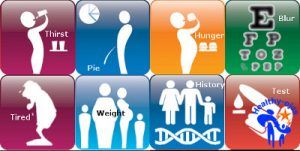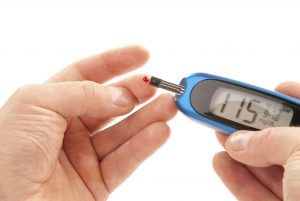What is Diabetes?
Diabetes mellitus is a metabolic disorder that occurs when the body cannot regulate the production or usage of insulin. Insulin is a hormone that converts sugar, starches, and other food into energy. This energy is either used immediately or stored as fat or glycogen. In a diabetic, the body does not produce enough insulin to move the sugar into cells, and the sugar gets accumulated in the blood.
- Type 1 diabetes
- Type 2 diabetes
- Gestational diabetes
Type 2 diabetes occurs later in life and hence is referred to as adult-onset diabetes. In type 2 diabetes, the muscle and fat cells in the body become resistant to insulin which causes the pancreas to make more insulin. As long as the pancreas continue to produce insulin to overcome this resistance, blood glucose levels remain normal. However, after several years the resistance of the cells continues to increase and the pancreas begin to produce lesser insulin. This result in hyperglycemia (abnormally high levels of sugar in the blood) and the symptoms of type 2 diabetes start manifesting. Type 2 diabetes is most often seen in obese or overweight people and the elderly.
Symptoms of Diabetes
Type 2 diabetes is asymptomatic in majority of the cases over a long period of time.. If symptoms do occur, they include fatigue, increased hunger (polyphagia), frequent urination (polyurea) and increased thirst (polydipsia), blurred vision, erectile dysfunction and poor wound healing..

Credit: Healthy-ojas
Treatment of Diabetes
The cornerstone of any diabetic therapy is healthy lifestyle. Although the immediate goal of diabetes treatment is to lower high blood glucose levels, it requires lifelong treatment and monitoring to prevent diabetes-related complications.
Every diabetic individual and his family members must be aware of some basic diabetes management skills such as, blood glucose monitoring, diabetic diet, medications, how to recognize and treat high and low blood sugar etc.
The current treatments for type 2 diabetes are as follows
 Self testing (using a glucometer) gives an exact blood sugar reading. The results are used to keep an optimal blood sugar levels by adjusting food, activity and medications.
Self testing (using a glucometer) gives an exact blood sugar reading. The results are used to keep an optimal blood sugar levels by adjusting food, activity and medications.
Diabetics should follow a strict diabetes diet to avoid blood sugar from becoming extremely high or low. The timings of the meals are also important as it prevents blood sugar levels fluctuating. Most diabetic diets are designed to be well-balanced meals which help in managing the body weight.
Regular physical activity can control blood sugar and helps shed extra fat to achieve a healthy weight. Exercise improves the blood flow and decreases the insulin resistance.
If diet and exercise fail to optimize the blood sugar levels medicines are prescribed. Some of medicines are alpha-glucosidase inhibitors,biguanides, exenatide, mitiglinide, pramlintide, sitagliptin, saxagliptin,meglitinides,sulfonylureas and thiazolidinediones.
If the combined therapy of medicines, exercise and diet still fails to optimize the blood sugar levels, insulin injections are prescribed.
PREVENTION
Although genes play the major role in type 2 diabetes, a healthy lifestyle (wholesome diet, exercise, adequate rest) goes a long way in preventing type 2 diabetes symptoms and associated complications. If you have any of the risk factors, early detection tests may be performed. Medications to delay or prevent the onset of diabetes have shown to be successful.




